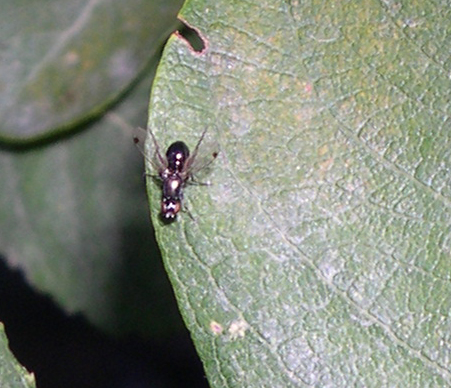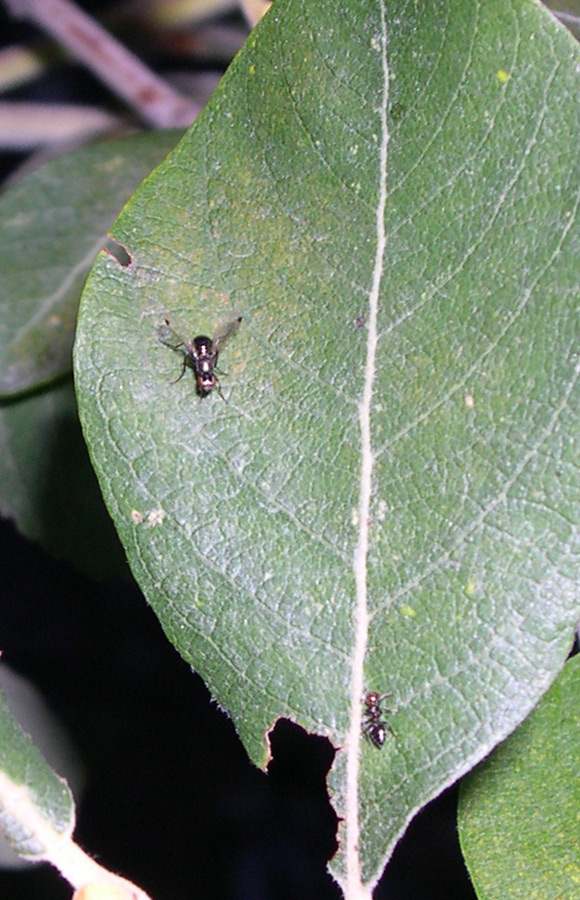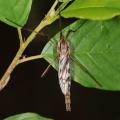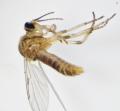Diptera.info :: Identification queries :: Diptera (adults)
Who is here? 1 guest(s)
|
A beauty of Sepsidae fly!
|
|
| jorgemotalmeida |
Posted on 11-09-2006 01:23
|
|
Member Location: Viseu - PORTUGAL Posts: 9296 Joined: 05.06.06 |
Hi I went to Serra da Estrela (the highest point in Portugal mailand) on 10th September 2006 and in "Well of the hell" ("PO?O DO INFERNO" ) I saw two beautiful flies. I saw one fly that seems to me a Platystomatidae fly... and anothe rfly I have no idea what can it be... The place:  The tree without leaves in beginning of stairs.. was the local where I saw the flies. Now with leaves  I thought that this could be Platystomatidae fly: (Rivellia sp.? or another? perhaps another... just one spot in each wing.) Sorry the pic is not so good... jorgemotalmeida attached the following image:  [169.59Kb] Edited by jorgemotalmeida on 11-09-2006 09:32 |
| jorgemotalmeida |
Posted on 11-09-2006 01:28
|
|
Member Location: Viseu - PORTUGAL Posts: 9296 Joined: 05.06.06 |
And here with Crematogaster scutellaris (Formicidae), the fly was moving its wings.
jorgemotalmeida attached the following image:  [187.23Kb] |
| Jan Willem |
Posted on 11-09-2006 07:12
|
|
Member Location: Waalwijk, The Netherlands Posts: 2150 Joined: 24.07.04 |
Hi Jorge, This is not a Platystomatidae but a Sepsidae (Sepsis sp.). Jan Willem |
|
|
|
| jorgemotalmeida |
Posted on 11-09-2006 09:30
|
|
Member Location: Viseu - PORTUGAL Posts: 9296 Joined: 05.06.06 |
Jan Willem wrote: Hi Jorge, This is not a Platystomatidae but a Sepsidae (Sepsis sp.). Jan Willem Hi Can you tell me why? Design of wing not usual for Platystomatidae? Body shape is very similar to Platystomatidae... Thank you! |
| Robert Nash |
Posted on 11-09-2006 09:42
|
|
Member Location: Ulster Museum, Belfast, Ireland Posts: 288 Joined: 11.11.05 |
Hi Jorge Go to the Glossary (top left)>black scavenger flies>Wikipedia Sepsidae the genera account is followed by External Links> Family description and images. Heaven (ly) photo of the Well of Hell. I remember it. Cheers from Ireland Robert |
| Jan Willem |
Posted on 11-09-2006 11:31
|
|
Member Location: Waalwijk, The Netherlands Posts: 2150 Joined: 24.07.04 |
Hi Jorge, I have to admit that it is difficult for me to tell you why I would call this specimen a sepsid. It is just that I have seen a lot of sepsids, so call it "experience". As to why I think it is not a platystomatid, I can only tell you that according to me the species of the genus Platystoma look totally different. The only other European genus is Rivellia of which only two species are known from Europe (i.e. syngenesiae and hispanica). R. syngenesiae has very different wing markings. I don't know R. hispanica, but if it looks a bit like syngenesiae, then it's certainly not the species you show here! Although it is probably correct, I may have been a bit hasty with calling your specimen Sepsis sp.. There are other genera with similar wing markings if I remember correctly. Jan Willem |
|
|
|
| Nikita Vikhrev |
Posted on 11-09-2006 15:43
|
|
Member Location: Moscow, Russia Posts: 9423 Joined: 24.05.05 |
Hi all. 1. As far as I know with this shape, size and place of wing spot it may be only Sepsis, at least in Europe. 2. And the question "why it is Sepsidae, Heleomyzidae ect..." is very fresh in my memory. And the fact that experts hardly can explaine "why", because they know directly genus... Nikita Nikita Vikhrev - Zool Museum of Moscow University |
|
|
|
| Kahis |
Posted on 11-09-2006 16:35
|
|
Member Location: Helsinki, Finland Posts: 1999 Joined: 02.09.04 |
Somehow this fly does not trigger my 'Sepsidae receptors'. My first thought was Ulidiidae. Compare with this (unidentified) Ulidid from a riverside forest in America: http://www.myrmec...idiid1.JPG.
Edited by Kahis on 11-09-2006 16:37 Kahis |
| jorgemotalmeida |
Posted on 11-09-2006 17:15
|
|
Member Location: Viseu - PORTUGAL Posts: 9296 Joined: 05.06.06 |
Kahis wrote: Somehow this fly does not trigger my 'Sepsidae receptors'. My first thought was Ulidiidae. Compare with this (unidentified) Ulidid from a riverside forest in America: http://www.myrmec...idiid1.JPG. This thread turns now very interesting.  I must to go there again in these days to take better photos with much better quality. But let?s try to realize what can be really this fly. I must to go there again in these days to take better photos with much better quality. But let?s try to realize what can be really this fly.  I agree that this can be Sepsidae. After all, it could be misleading for a Platystomatidae one... but the design of wing is different, so I agree with Sepsidae fly (thanks Jan Willem and Nikita)... and not Ulidiidae... and now, please, correct if I'm getting wrong: this fly didn?t have a pronounced tip abdomen like these: http://www.pbase...._ulidiidae I agree that this can be Sepsidae. After all, it could be misleading for a Platystomatidae one... but the design of wing is different, so I agree with Sepsidae fly (thanks Jan Willem and Nikita)... and not Ulidiidae... and now, please, correct if I'm getting wrong: this fly didn?t have a pronounced tip abdomen like these: http://www.pbase...._ulidiidaeBut I don?t know by sure. So, I will enjoy to "hear" more opinions. It would help to know the habitat AND the body mean size of these two families: Ulidiidae and Sepsidae flies. This fly was about 5 mm. Not sure. One another question: why some flies mimics ants (I?m talking about Sepsidae flies, for example) if they don?t catch them? And in this way can be more subject to predators too... |
| jorgemotalmeida |
Posted on 11-09-2006 17:35
|
|
Member Location: Viseu - PORTUGAL Posts: 9296 Joined: 05.06.06 |
Kahis wrote: Somehow this fly does not trigger my 'Sepsidae receptors'. My first thought was Ulidiidae. Compare with this (unidentified) Ulidid from a riverside forest in America: http://www.myrmec...idiid1.JPG. the eyes of the mystery  fly are more red than this Ulidiidae fly... And abdomen not so broad, but this is can be questionable.. fly are more red than this Ulidiidae fly... And abdomen not so broad, but this is can be questionable.. |
| Nikita Vikhrev |
Posted on 11-09-2006 19:14
|
|
Member Location: Moscow, Russia Posts: 9423 Joined: 24.05.05 |
I asked Andrey Ozerov to look at this fly, to tell Sepsidae or not.
Nikita Vikhrev - Zool Museum of Moscow University |
|
|
|
| Kahis |
Posted on 11-09-2006 20:20
|
|
Member Location: Helsinki, Finland Posts: 1999 Joined: 02.09.04 |
jorgemotalmeida wrote: Kahis wrote: Somehow this fly does not trigger my 'Sepsidae receptors'. My first thought was Ulidiidae. Compare with this (unidentified) Ulidid from a riverside forest in America: http://www.myrmec...idiid1.JPG. the eyes of the mystery  fly are more red than this Ulidiidae fly... And abdomen not so broad, but this is can be questionable.. fly are more red than this Ulidiidae fly... And abdomen not so broad, but this is can be questionable..Eye color can vary with health of fly, amount of light, orientation, day of week  . .
Kahis |
| jorgemotalmeida |
Posted on 11-09-2006 20:42
|
|
Member Location: Viseu - PORTUGAL Posts: 9296 Joined: 05.06.06 |
Kahis wrote: jorgemotalmeida wrote: Kahis wrote: Somehow this fly does not trigger my 'Sepsidae receptors'. My first thought was Ulidiidae. Compare with this (unidentified) Ulidid from a riverside forest in America: http://www.myrmec...idiid1.JPG. the eyes of the mystery  fly are more red than this Ulidiidae fly... And abdomen not so broad, but this is can be questionable.. fly are more red than this Ulidiidae fly... And abdomen not so broad, but this is can be questionable..Eye color can vary with health of fly, amount of light, orientation, day of week  . .even the day of week!  Agree, even our eyes could have colour differents depending of orientation of light, and amount too, and health... ok, the same. Agree, even our eyes could have colour differents depending of orientation of light, and amount too, and health... ok, the same.  So we just play with body shape and the wings.. unfortunately not so clear. Let?s wait for more opinions!  |
| jorgemotalmeida |
Posted on 11-09-2006 21:57
|
|
Member Location: Viseu - PORTUGAL Posts: 9296 Joined: 05.06.06 |
just for curiosity: here you can see a good image 360? of the local I saw the flies.  http://www.360por...oeira.html |
| Jan Willem |
Posted on 12-09-2006 07:39
|
|
Member Location: Waalwijk, The Netherlands Posts: 2150 Joined: 24.07.04 |
Hi, Kahis certainly made me doubt my statement that it is a sepsid (I've made mistakes with this before  ). However, comparing it with the unidentified ulidiid, I'm still inclined to think it's a sepsid. The placement of the spot is rather apical in the ulidiid and more pre-apical in the specimen of Jorge. ). However, comparing it with the unidentified ulidiid, I'm still inclined to think it's a sepsid. The placement of the spot is rather apical in the ulidiid and more pre-apical in the specimen of Jorge.I'm curious about the opinion of Andrey Ozerov. Jan Willem |
|
|
|
| Andrey Ozerov |
Posted on 12-09-2006 12:11
|
|
Member Location: Posts: 63 Joined: 05.06.06 |
I think it is female of Sepsis fulgens Mg. |
|
|
|
| jorgemotalmeida |
Posted on 12-09-2006 18:27
|
|
Member Location: Viseu - PORTUGAL Posts: 9296 Joined: 05.06.06 |
Andrey Ozerov wrote: I think it is female of Sepsis fulgens Mg.  Sorry for my annoying  questions but correct if I'm wrong... female in this case (sepsidade flies)... it?s because that has a broad abdomen? Or eyes more separated than males? questions but correct if I'm wrong... female in this case (sepsidade flies)... it?s because that has a broad abdomen? Or eyes more separated than males? I suppose that Spesidae flies don?t have an extension of abdomen like Ulidiidae flies. Thank you all for help!  |
| Nikita Vikhrev |
Posted on 12-09-2006 19:33
|
|
Member Location: Moscow, Russia Posts: 9423 Joined: 24.05.05 |
There are several ways: 1. Male's f1 and t1 usualy have strong bristles or spines. 2. Female has more fatty, more "woman" abdomen. 3. If your given size is correct (5mm) it also means that it is female, most probably, as male are less. Nikita Nikita Vikhrev - Zool Museum of Moscow University |
|
|
|
| Jump to Forum: |













